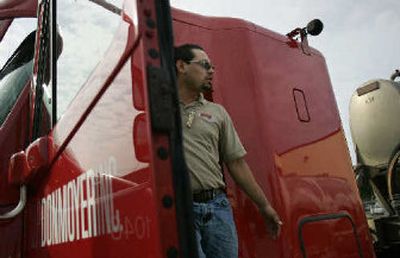Upward mobility

READING, Pa. — Jose Frias scrubbed a chicken processing plant for six years, never earning more than $8.50 an hour. The latest of Tomas Rodriguez’ three layoffs came in December when he lost his factory job making door knobs and tools. And Alfonso Lua left his native Mexico 26 years ago to pick fruit and vegetables in the U.S. for $10,000 a year.
Nowadays, Frias and Rodriguez are learning to be long-haul commercial truck drivers while Lua has been driving big rigs for seven years, making six times what he brought home from the orchards.
“This is easier, this is better,” Lua said, standing beside his bright red rig one recent morning at a company terminal in York, Pa. “I don’t work (outdoors) in the hot weather or the cold weather. I’m in my truck, I have air conditioning and I have heat.”
Their quests for more job security and better wages led them down a road that driver-starved trucking companies are hoping more Hispanics will follow.
Beset by an aging work force and high turnover, trucking companies that traditionally culled drivers from middle America are recruiting in urban Hispanic communities, advertising in Spanish, appealing to high-school students and setting up booths at job fairs.
Truck-driving schools also are responding to demand from the industry and from Hispanics hungry for better-paying jobs that do not require fluent English.
“The truck driver has been the domain of the white male for years and years and years, and the face of the truck driver is changing,” said Robert Lake, the executive publisher of Truckers News en EspaInol. “And the companies that want to be profitable and fill their trucks have to look outside of that one individual.”
Hispanics are the country’s fastest-growing ethnic group, accounting for an estimated one in seven of the nation’s 1.3 million long-haul truckers, the same proportion as in the overall U.S. population.
But that’s not good enough for some trucking executives at a time when one in six long-haul truckers are nearing retirement and driver recruitment is lagging industry growth. The ranks of long-haul truck drivers expanded by 1.6 percent last year, according to federal data, while industry expansion is projected at 2.2 percent a year over the next decade. If those trends hold, a current 20,000-driver shortfall will balloon to 110,000 by 2014, a figure that doesn’t include the approximately 219,000 truckers expected to retire during that period, according to a study commissioned by the American Trucking Associations, an industry group based in Alexandria, Va.
To close the gap, companies want trucking to be attractive to Hispanics, who are joining the broader U.S. work force at an eye-popping rate and filling one of every three job openings, according to the Bureau of Labor Statistics.
“In correlation to the growth of the (Hispanic) population, we’re not reaching out as fast as we should,” said Larry Johnson, president of the Nebraska Trucking Association.
So Johnson’s organization has sought to establish a presence in heavily Hispanic south Omaha, where it sponsors stay-in-school programs while the traditional recruiting ground of family farming communities shrinks.
Schneider National Inc. of Green Bay, Wisc., one of the country’s largest companies, has tapped Hispanic business groups for help in placing Spanish-language advertisements and participating in job fairs. Chattanooga, Tenn.-based US Xpress Enterprises Inc. is advertising in Spanish for drivers and seeking Spanish-speaking recruiters, payroll clerks and dispatchers to cushion the arrival of more Hispanic drivers.
“If you keep doing business like you did yesterday, you’re eventually going to get run over,” said Gary Kelley, a US Xpress vice president. “It’s going to be difficult and expensive, but it’s going to be well worth the investment.”